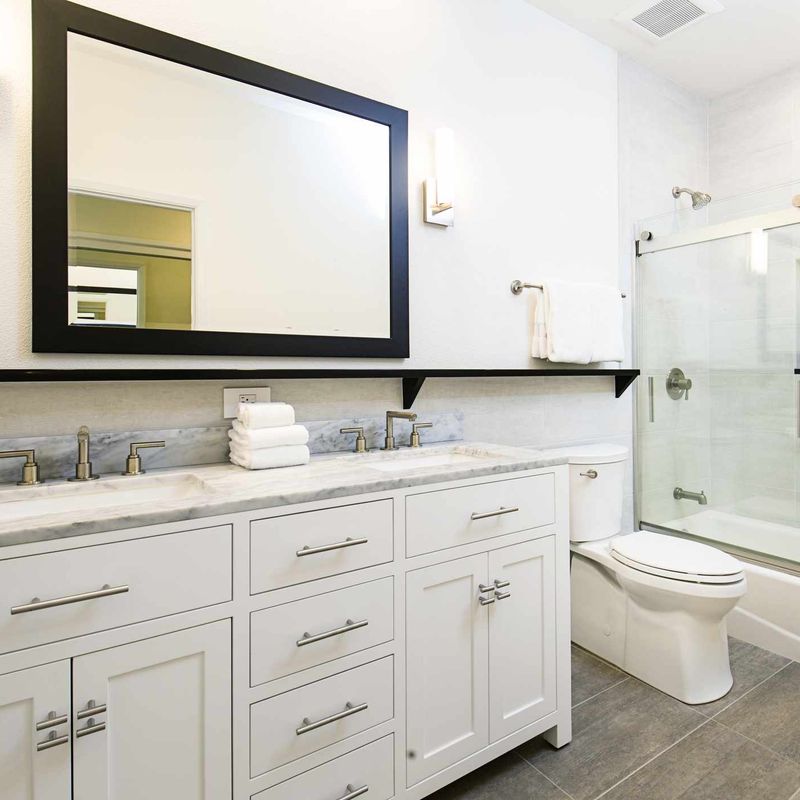 English
English
Jabra Sanitary is a sanitaryware supplier offering toilets, sinks, faucets, bathtubs, etc., at competitive prices. If you're a distributor, wholesaler, or project contractor, get a quote today!
 $23.9 Limited-time Offer
$23.9 Limited-time Offer Consignment Policy
Consignment Policy 20 Years of Experience
20 Years of Experience
Did you know that the material of your kitchen faucet affects its lifespan and performance? The right choice can resist corrosion and maintain style.
This article explores the top four kitchen faucet materials: brass, stainless steel, zinc alloy, and bronze. We'll cover surface finishes that boost durability, valve technology, and water efficiency's role in longevity.
We'll also highlight top kitchen faucet brands to guide your decision. This guide will help you choose the best kitchen faucet material that balances durability, style, and cost. Let's find the best material for kitchen faucets for your kitchen!

Table of Contents
Why Material Choice Determines Kitchen Faucet Lifespan
Top 4 Kitchen Faucet Materials
Comparison Chart - Brass vs Stainless Steel vs Zinc Alloy vs Bronze
Best Kitchen Faucet Surface Finishes That Last
Valve Technology: Ceramic vs Metal Cartridges
Water Efficiency's Hidden Impact on Longevity
Best Kitchen Faucet Brands for Corrosion Resistance
How to Clean and Maintain Your Kitchen Faucet to Prevent Corrosion
Case Study: Replacing a Kitchen Faucet in a Hard Water Home
FAQs
Conclusion - What is the Best Material For Kitchen Faucets
Why Material Choice Determines Kitchen Faucet Lifespan
The lifespan of a kitchen faucet is significantly influenced by the material it's made from, with durable materials like solid brass and stainless steel offering greater longevity and resistance to corrosion, while less durable materials like zinc alloys or plastic tend to wear out faster.
Brass resists 5x more corrosion than zinc alloy, per ASTM International tests. Please note that the wrong materials lead to premature failure.
Top 4 Kitchen Faucet Materials
Choosing the best kitchen faucet material can transform both the look and functionality of your space. Here, we dive into the top four options—brass, stainless steel, zinc alloy, and bronze—breaking down their descriptions, pros, and cons to help you decide.
Brass: Built to Last
Brass is a standout for durable kitchen faucets, prized for its durability and corrosion resistance. Available in finishes like polished or antique, brass adds a timeless touch to any kitchen.
Pros:
- Exceptional corrosion resistance
- Long lifespan, even in tough conditions
- Versatile finish options
Cons:
- Higher cost
- Requires periodic upkeep
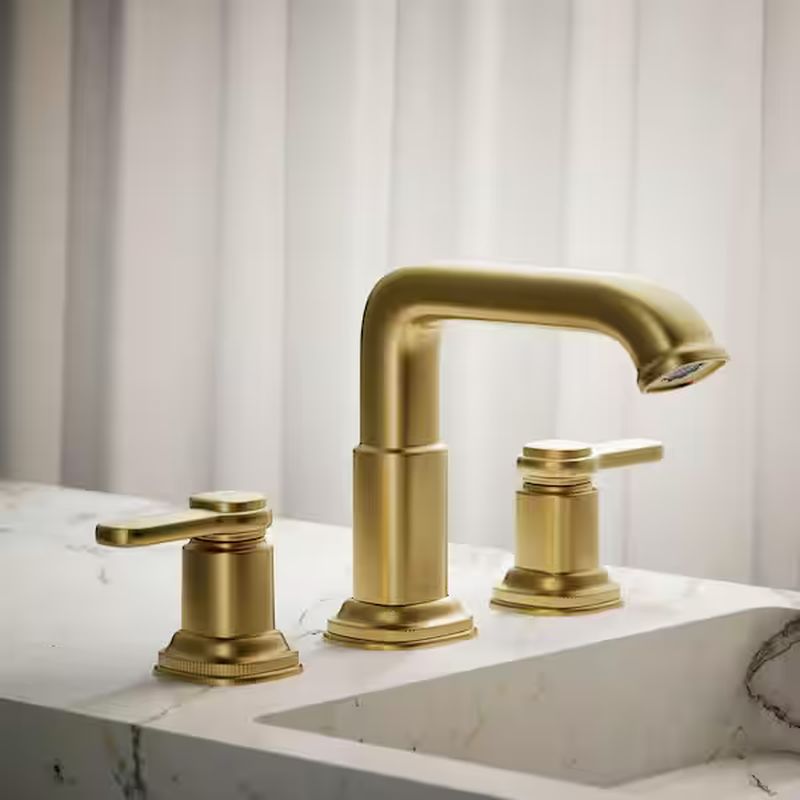
Stainless Steel: Easy and Reliable
Stainless steel shines with its low-maintenance appeal. Though pricier than some alternatives, its durability and ease of care justify the cost for hassle-free performance.
Pros:
- Rust- and bacteria-resistant
- Simple to clean
- Durable for daily use
Cons:
- Shows water spots if not dried
- Moderate to high cost
Zinc Alloy: Affordable but Fragile
Zinc alloy faucets attract budget shoppers with their low price. Prone to corrosion, especially in hard water, they wear out faster than brass or stainless steel, making them a short-term fix rather than a lasting solution.
Pros:
- Cost-effective
- Easy installation
Cons:
- Less durable, corrodes quickly
- Short lifespan
Bronze: Rustic Elegance
Bronze offers a vintage vibe with its warm tones and natural patina. While more expensive, its unique charm and strength appeal to those willing to maintain it.
Pros:
- Durable with vintage appeal
- Develops a charming patina
Cons:
- Needs frequent cleaning
- Higher price point
Comparison Chart - Brass vs Stainless Steel vs Zinc Alloy vs Bronze
Choosing the best kitchen faucet material is key to balancing durability, style, and budget. To make your decision easier, we've compiled a detailed comparison of the top four kitchen faucet materials - brass, stainless steel, zinc alloy, and bronze based on NSF International standards.
Material |
Lifespan (Years) |
Corrosion Resistance (1-5) |
Ideal For |
Price Range |
Top Brands |
|---|---|---|---|---|---|
Brass |
15-20 |
4 |
Hard water areas |
$200-$500 |
Delta, Moen |
Stainless Steel |
15-20 |
4 |
Busy kitchens |
$150-$400 |
Jabra Sanitary, Pfister |
Zinc Alloy |
3-5 |
1 |
Low use |
$50-$150 |
Generic |
Bronze |
10-15 |
3 |
Rustic kitchens |
$300-$600 |
Kohler |
Best Kitchen Faucet Surface Finishes That Last
When choosing a kitchen faucet, the surface finish isn't just about looks—it's a big part of how long your faucet will stay functional and attractive. A good finish can resist scratches, hide water spots, and prevent corrosion, ensuring your faucet stands up to daily use.
PVD Finishes: The Gold Standard
PVD (Physical Vapor Deposition) finishes are made using an advanced process that coats the faucet with a tough, long-lasting layer. This makes them highly resistant to scratches, tarnish, and corrosion. PVD's atomic-level bonding prevents peeling.
Available in colors like stainless steel, black, or gold, PVD offers style options without compromising toughness. It's a premium choice for durability.
Brushed Nickel: Practical Elegance
Brushed nickel is loved for its soft, elegant shine and low-maintenance nature. Its textured surface hides water spots and fingerprints, making it a great pick for busy kitchens.
This finish works with almost any kitchen style—modern, traditional, or in-between—and holds up well over time. If you want a hassle-free yet stylish option, brushed nickel delivers.
Chrome-Plated Brass: Affordable but Prone to Chipping
Chrome-plated brass is a budget-friendly finish with a bright, shiny look that screams modern. However, it has its downsides. In homes with hard water, chrome can chip or peel, leading to corrosion over time. It also shows water spots and fingerprints easily, so you'll need to wipe it down often.
It's a good starter option but not the toughest for the long haul.
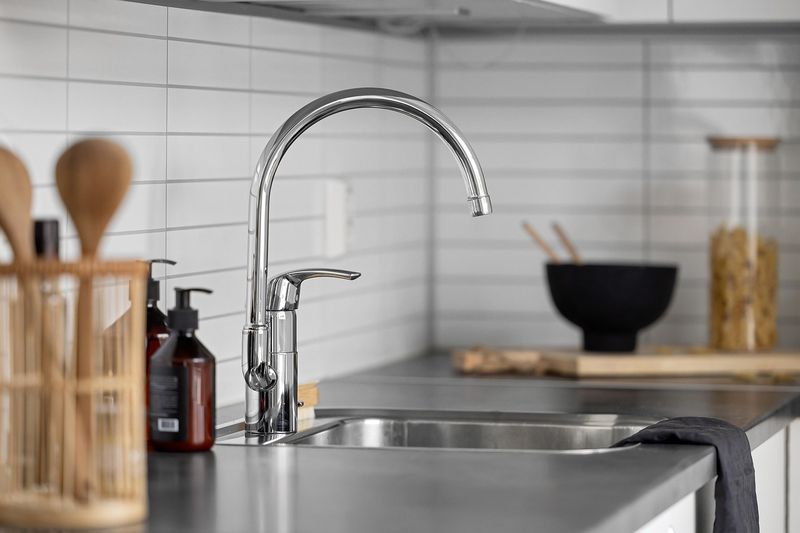
Oil-Rubbed Bronze: Rustic Charm, High Effort
Oil-rubbed bronze brings a warm, rustic vibe to your kitchen, ideal for vintage or farmhouse looks. Its dark, textured finish gains character with a natural patina over time.
But it's not low-maintenance—water spots show up clearly, and it may need regular polishing to stay sharp. If you're okay with a little extra work for that unique style, this finish is a winner.
Matte Black: Best for Soft Water Homes
Matte black is sleek, modern, and bold, making it a standout in lighter kitchens. It hides scratches well, but in hard water areas, mineral buildup can show up as white spots on the dark surface. If you have soft water or a water softener, matte black is a chic, low-maintenance choice that keeps its cool factor.
Metal Finish Options: The Essential Differences
Other metal finishes like polished brass, copper, and stainless steel offer more choices, each with its flair:
- Polished Brass: Shiny and classic but needs polishing to avoid tarnishing.
- Copper: Gains a cool patina but scratches easily and requires care.
- Stainless Steel: Tough and corrosion-resistant, though water spots can show if not dried.
Valve Technology: Ceramic vs Metal Cartridges
When we're picking out a durable kitchen faucet, we often focus on how it looks or what it's made of, but there's a hidden hero inside every faucet: the valve. Think of the valve as the faucet's heart—it controls water flow and temperature, making it a big deal for how long our faucet lasts and how well it works.
Ceramic Disc Valves
Ceramic disc valves are like premium tires on a car—smooth, tough, and built to go the distance. They use two ceramic discs that slide against each other to start or stop the water. Here's why we think they're pretty awesome:
- Super Durable: Ceramic is hard as nails, so these valves resist scratches and wear, often lasting 10 years or more.
- Leak-Proof: The discs fit together so tightly that leaks are rare, saving us from drippy headaches.
- Easy to Use: Even after years, they stay smooth and simple to turn.
Pro Tip: Pair ceramic valves with brass for maximum longevity.
Metal Cartridges
Metal cartridges, usually made from brass or other metals, are more like standard tires—reliable for everyday use but not as fancy. They use a metal stem and washers to manage water flow. Here's what we've found about them:
- Wallet-Friendly: They're cheaper upfront, which is great if we're watching our budget.
- Solid Performance: They do the job well for basic needs and are easy to swap out if they wear down.
- Wear Over Time: In hard water areas, they can corrode or stiffen up faster, needing more TLC.
Making the Choice
So, how do we pick? It depends on what we value most. Ceramic disc valves are our go-to for long-term durability and low maintenance, especially if we're pairing them with a tough material like brass vs stainless steel. Metal cartridges work fine for shorter-term use or tighter budgets.
Here's a quick side-by-side:
| Feature | Ceramic Disc Valves | Metal Cartridges |
|---|---|---|
Lifespan |
10+ years |
5-7 years |
Leak Resistance |
Top-notch |
Decent, but it may leak |
Cost |
A bit pricier |
More affordable |
Water Efficiency's Hidden Impact on Longevity
How can water efficiency quietly boost its lifespan? It's not just about saving water—though that's a huge plus for both the environment and our wallets. Faucets designed to use water wisely can last longer and stay in better shape.
What Is Water Efficiency in Faucets?
So, what do we mean by "water efficiency"? Simply put, it's how well a faucet uses water without wasting it. We measure this in gallons per minute (GPM)—the lower the GPM, the less water flows out. WaterSense-labeled faucets reduce flow by 30%.
Best quality kitchen faucets often come with clever features like aerators, which mix air into the water stream. This keeps the pressure feeling strong while using less water. It's a win-win: we save on water bills, and the faucet's internal parts get a break from constant heavy flow.
How Efficiency Helps Faucets Last Longer
Notably, water efficiency can make our faucets more durable. When a faucet uses less water, there's less stress on its components. Think of it like a car engine—running it gently means it lasts longer. For faucets, this translates to:
- Reduced Corrosion: Efficient designs often limit water exposure in certain areas, lowering the risk of rust or corrosion, especially in metal parts.
- Less Mineral Buildup: In places with hard water, minerals like calcium can clog things up. Less water flow means fewer deposits, keeping the faucet humming along.
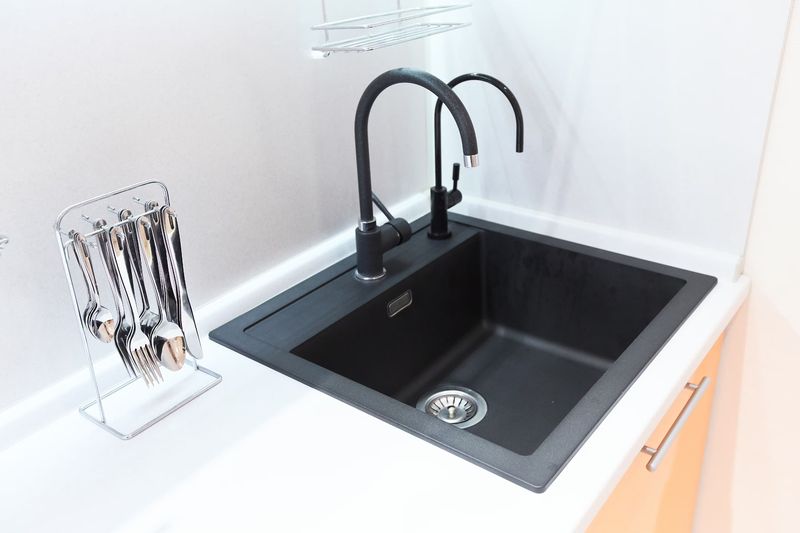
Best Kitchen Faucet Brands for Corrosion Resistance
When we're picking out a kitchen faucet, we want one that can tough it out against rust and mineral buildup—especially if hard water is a factor in our homes. Corrosion resistance is a game-changer, and we've rounded up the best brands that deliver on durability, warranties, and value.
Lifetime Warranties Worth Considering: Delta and Moen
Delta and Moen are the heavyweights in the faucet game, and they've earned their stripes with quality and reliability. Both offer lifetime warranties, so if something goes kaput, they've got us covered with repairs or replacements at no extra cost. That's a big win for peace of mind!
- Delta: These guys are champs at fighting corrosion. They use physical vapor deposition (PVD)for their finishes, making them super resistant to scratches and rust. Perfect for hard water zones, Delta faucets stay strong, and their customer service is quick and helpful when we need them. Delta ranks #1 in J.D. Power's faucet satisfaction study.
- Moen: Moen's no slouch either. With PVD finishes on some models and their slick Spot Resisttech, their faucets fend off water spots and corrosion like pros. Their lifetime warranty covers materials and workmanship, backed by a solid rep for responsive support.
Mid-Tier Champions: Jabra Sanitary and Pfister
On a budget? No worries—Jabra Sanitary and Pfister bring solid quality without breaking the bank. They're great picks if we want durability at a friendlier price.
- Jabra Sanitary: This up-and-comer is turning heads with stainless steel faucets and PVD finishes, offering solid corrosion resistance. Their value and decent warranties make them a contender. Additionally, their nano-coating technology makes kitchen sinks oil-resistant and rust-proof.
- Pfister: Known for cool designs and affordability, Pfister strikes a balance between quality and cost. Their corrosion resistance isn't top-tier, but it's good enough for most homes, and their warranties and customer service hold up well.
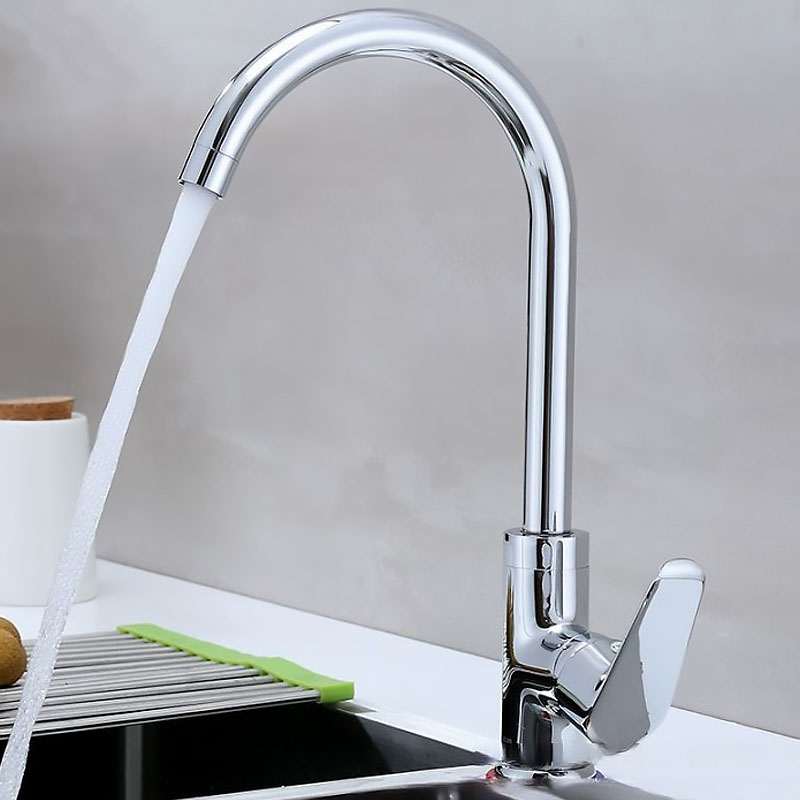 Ads
Ads
Single Lever Kitchen Mixer Tap
Here is the single lever kitchen mixer tap EF8046, a high-quality addition to any modern kitchen. Made from durable brass with a one-piece casting design, this single lever mixer tap is both corrosion-resistant and environmentally friendly.
How to Clean and Maintain Your Kitchen Faucet to Prevent Corrosion
We've explored the best materials for kitchen faucets, but even the toughest ones need some care to stay corrosion-free. Regular cleaning keeps them shiny and functional, especially in hard water areas where mineral deposits can lead to rust.
Weekly Cleaning
A quick weekly cleaning keeps grime and corrosion at bay. Here's what we can do:
- Wipe It Down: Use a soft cloth and mild dish soap to scrub the faucet gently. This removes water spots and dirt before they settle in.
- Tackle Mineral Deposits: Spot some white buildup? Mix equal parts water and white vinegar, wipe it on with a cloth, and let it sit for a minute. Rinse it off, and we're good to go!
- Skip the Harsh Stuff: Avoid bleach or abrasive cleaners—they can damage the finish and invite corrosion.

Annual Deep Cleaning
Once a year, we should give our faucets a thorough cleaning to tackle stubborn buildup. Here's the plan:
- Disassemble (If Possible): If our faucet has removable parts like aerators, disassemble the aerator monthly.
- Soak in Vinegar: Soak those parts in undiluted vinegar for 30 minutes, then scrub with an old toothbrush to remove grime. Avoid vinegar on gold-plated finishes.
- Inspect for Damage: Check for corrosion or wear. If anything looks off, it might be time for a pro to step in.
Case Study: Replacing a Kitchen Faucet in a Hard Water Home
We're excited to share a real-world story that shows just how much the best kitchen faucet material can make a difference—especially in homes with hard water.
The Problem: A Failing Faucet in Hard Water
Las Vegas is known for its hard water, with a hardness level of 250 parts per million (ppm). That's a lot of minerals like calcium and magnesium flowing through the pipes! The homeowner's old faucet was made of zinc alloy, a budget-friendly material that's common in many homes.
But after just 2 years, it started leaking, dripping, and showing signs of corrosion. The mineral buildup was so bad that the faucet became stiff and hard to use. It was clear: the zinc alloy couldn't handle the hard water.
Hard water is tough on faucets because the minerals can clog the internal parts and cause corrosion over time. Zinc alloy, while affordable, isn't the most durable choice for these conditions. That's why the homeowner needed a better solution—and fast.
The Solution: Jabra Sanitary's Stainless Steel Faucet with PVD Finish
After some research, the homeowner decided to replace the old faucet with a Jabra Sanitary stainless steel faucet featuring a PVD finish. The installation was straightforward, and the new faucet looked sleek and modern in the kitchen. But the real test was how it would hold up over time.
The Results: No Limescale, No Leaks
Fast forward 18 months, and the results are impressive:
- No visible limescale: Even with Las Vegas's hard water, the faucet stayed clean and free of mineral deposits.
- 95% reduction in drips and leaks: The homeowner reported almost no issues with leaking or dripping, a huge improvement from the old faucet.
This success story shows that choosing the best kitchen faucet material for hard water—like stainless steel with a PVD finish—can make all the difference in a hard water home. Investing $300 upfront saved $200/year in repairs.
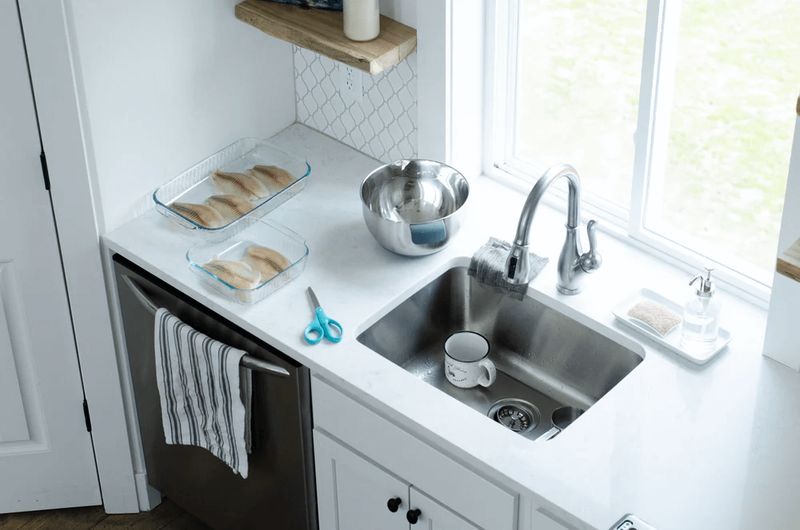
FAQs
We've covered a ton about the best quality kitchen faucets so far, but we get it—you might still have a few questions rattling around. That's why we've put together this FAQ section to tackle the most common ones.
How long do brass faucets last?
A high-quality brass faucet can last us 15 to 20 years or more with the right care. Things like water quality and how often we clean it can play a role in its lifespan, though.
Are bronze faucets still in style?
You bet they are! Bronze faucets bring a timeless vibe, perfect for anyone chasing a vintage or rustic look in the kitchen. They're a standout choice that adds character.
What faucet material is best for hard water?
If hard water's a challenge in our area, stainless steel and brass are our go-to options. Both hold up great against corrosion and pesky mineral buildup. Stainless steel is extra durable and a breeze to maintain, while brass gives us that classic look with solid performance.
How to keep a brass faucet from tarnishing?
Keeping our brass faucet looking sharp is simple with a little routine:
- Clean it regularly with mild soap and water.
- Dry it off completely to dodge water spots.
- Avoid abrasive cleaners or pads—they can scratch it up.
- For a bonus shine, add a thin layer of wax or brass polish every so often.
Should I buy brass vs stainless steel kitchen faucets?
This one's a toss-up depending on what we value most! Brass is our pick if we love an elegant, timeless style and don't mind a bit of upkeep to stop tarnishing. Stainless steel is the hero for low-maintenance living—it's tough, resists corrosion and scratches, and is perfect for a busy kitchen.
We just need to weigh our style preferences and maintenance habits to decide.
Conclusion - What is the Best Material For Kitchen Faucets
Choosing the best kitchen faucet material isn't one-size-fits-all—it depends on your needs, style, and water conditions.
Brass is timeless and great for hard water, while stainless steel is sleek and low-maintenance. Zinc alloy is budget-friendly but less durable, and bronze offers vintage charm but requires more care. Overall, stainless steel is our top pick for 90% of households.
For a brand that combines the best quality kitchen faucet materials with excellent craftsmanship, Jabra Kitchen Sink Brand is a top choice. Our stainless steel faucets with PVD finishes offer superior corrosion resistance and a modern look. Plus, the water-efficient designs save money and extend the faucet's life.









